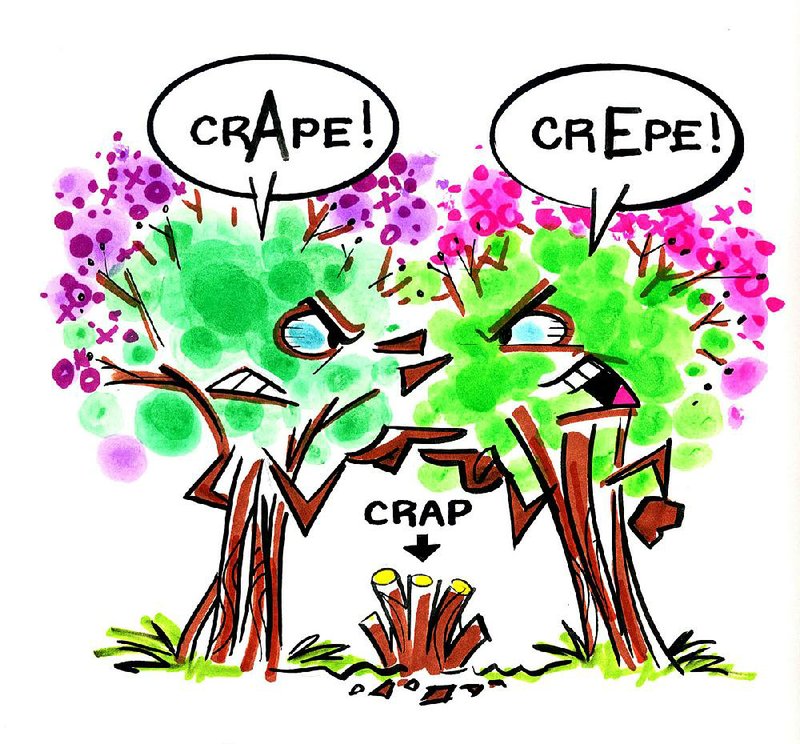Q I am so tired of hearing "crape" when it is "crepe"!! Why do you insist upon perpetuating an incorrect spelling? No wonder so many people pronounce it as crap! It is from the French language, crepe meaning crinkled. Have you never noticed the fabric known as crepe which has little crinkles all over it? Have you never looked at the blossoms of crepe myrtles and seen the little crinkles and hence where they got their name? Maybe you should get a copy of the Southern Living magazine and read The Grumpy Gardener; at least he always uses the correct spelling!!!!
A This is sort of like "You say po-ta-to and I say po-tah-to." Both spellings are allowed, but crape myrtle is the one most often used. I was taught in college that the common name for Lagerstroemia indica was "crape myrtle." I just browsed through many reference books on my shelf, which include the American Horticultural Society Encyclopedia and my horticulture bible by Michael Dirr, and they all spell it crape. Also, if you visit the Crape Myrtle Society of America, they spell it using "a" instead of "e." The only place I see it spelled "crepe myrtle" is in the Southern Living books and magazines. I have even seen The Grumpy Gardener chide someone else in Southern Living magazine for spelling crape myrtle with an "a." However you spell it, crape myrtles are lovely plants for the garden, but I guess they can look like "crap" if they are pruned incorrectly, which happens all too frequently.
Q I have a crosscut shredder that I have been using since before Christmas, and I now have more than four big garbage bags of confetti that I want to use for mulch. However I don't think that it's going to look good or that my neighbors would appreciate it if it blows all over the neighborhood. What should I do? One friend suggested that I cover it with pine straw after wetting it down. Another suggested that I cover it with regular mulch -- just enough to cover the shredded paper. The guy who takes care of my yard says to junk it and go to Wal-Mart or Home Depot and buy some bags of mulch. That is not my preference. I'd like to use the shredded paper if possible, but I do want the beds and my yard to look good. What would you suggest?
A I use shredded paper, newspaper and cardboard all the time in my gardens. In the backyard where no one can see it, I sometimes just use the shredded paper, but in the front beds I put down a layer of paper, and then cover with shredded hardwood in my flower beds and rice hulls in my vegetable gardens. It gives you an added layer of mulch for half the cost of buying mulch.
Q We've had a maple tree in our yard for 15 or so years. My husband trimmed the branches over the driveway about three weeks ago because of droppage from the tree. It had begun to get tiny leaves but the little leaves have mostly turned brown; but there is some green. Will it recover?
A I don't think the pruning had anything to do with the leaves turning brown. In the northern counties, some of our trees were putting on new foliage when they were zapped by a freeze. Be patient and see if you don't see healthy new green leaves forming now.
Q We have two large Leyland cypress trees that were heavily infested with bagworms last year. I sprayed them with a spinosad pesticide. It seems to have worked pretty well, but this year I was hoping to be able to spray before the little critters managed to overwhelm my defenses. After this mild winter, though, I am not sure when to spray. Can you help me?
A Normally bagworms get active mid-May through mid-June. Because of the mild winter, they could arrive a tad early. If you want to take a preventive approach, you can use the organic Bacillus thuringiensis, commonly called BT or Thuricide. Spray the trees once a week from early May until the end of May, and then monitor the trees. Hopefully you can catch them when they hit, and you won't see the ugly bags forming.
Janet B. Carson is a horticulture specialist for the University of Arkansas Cooperative Extension Service. Write to her at 2301 S. University Ave., Little Rock, Ark. 72204 or email her at
jcarson@arkansasonline.com
HomeStyle on 04/16/2016
